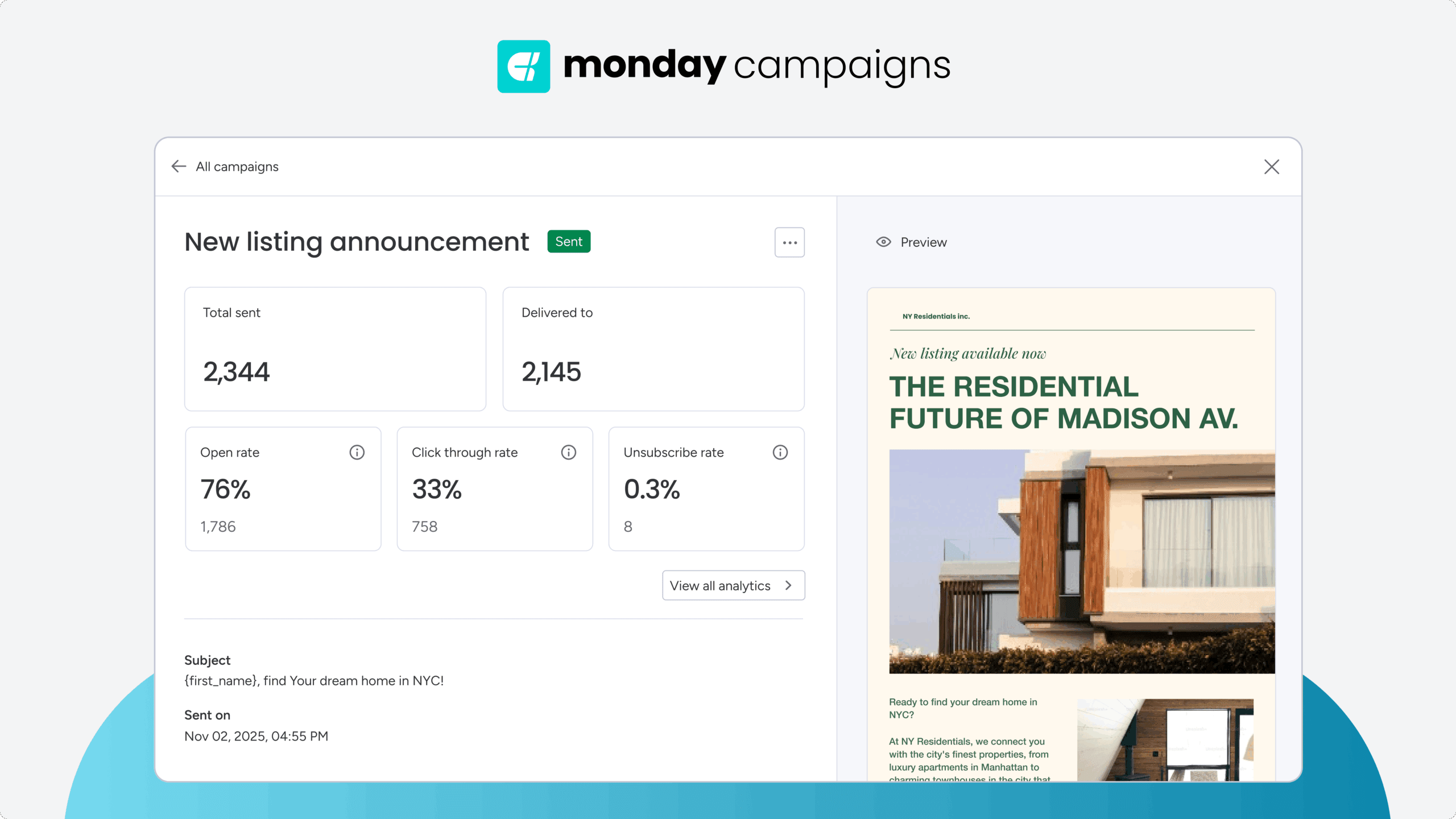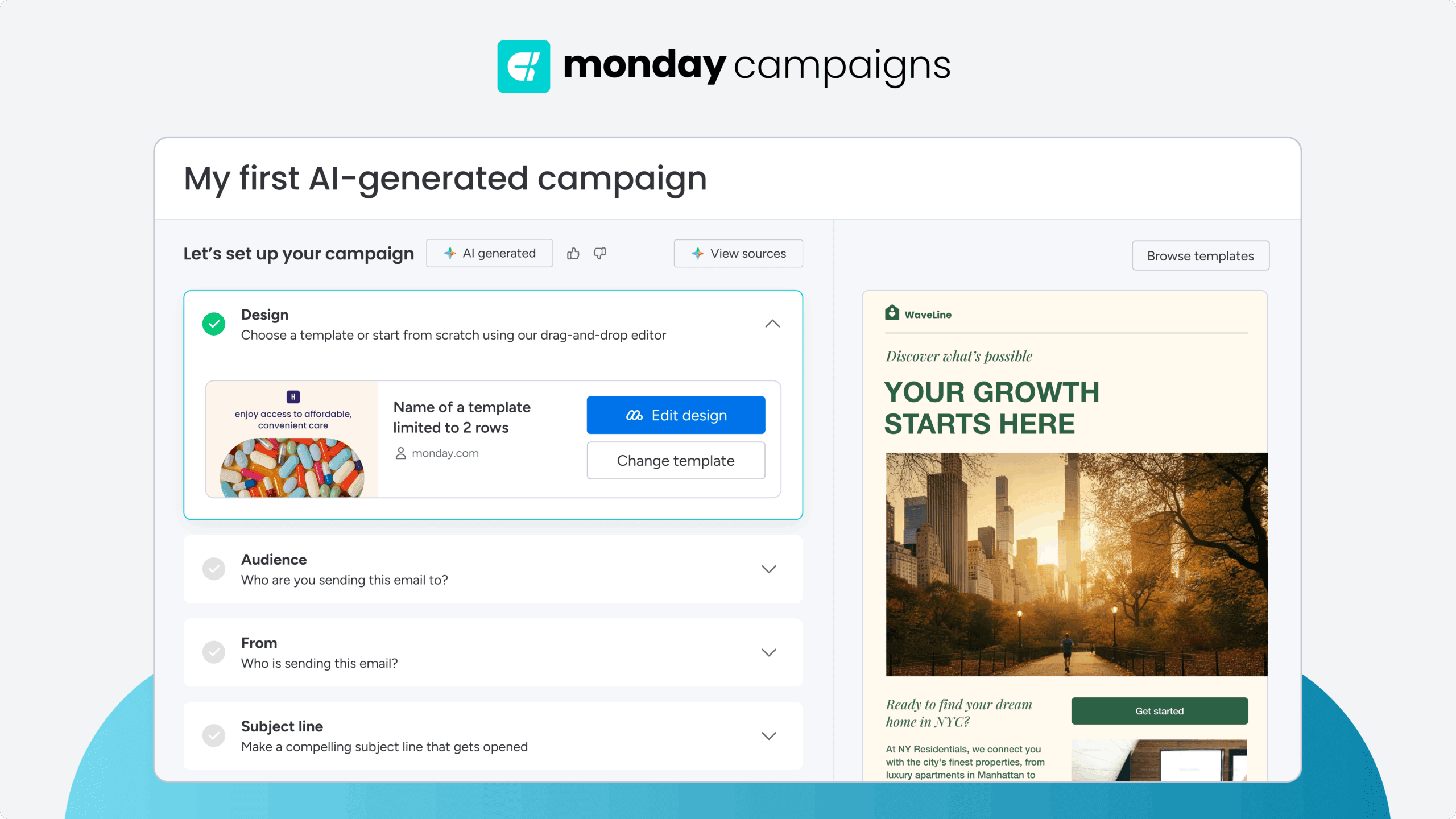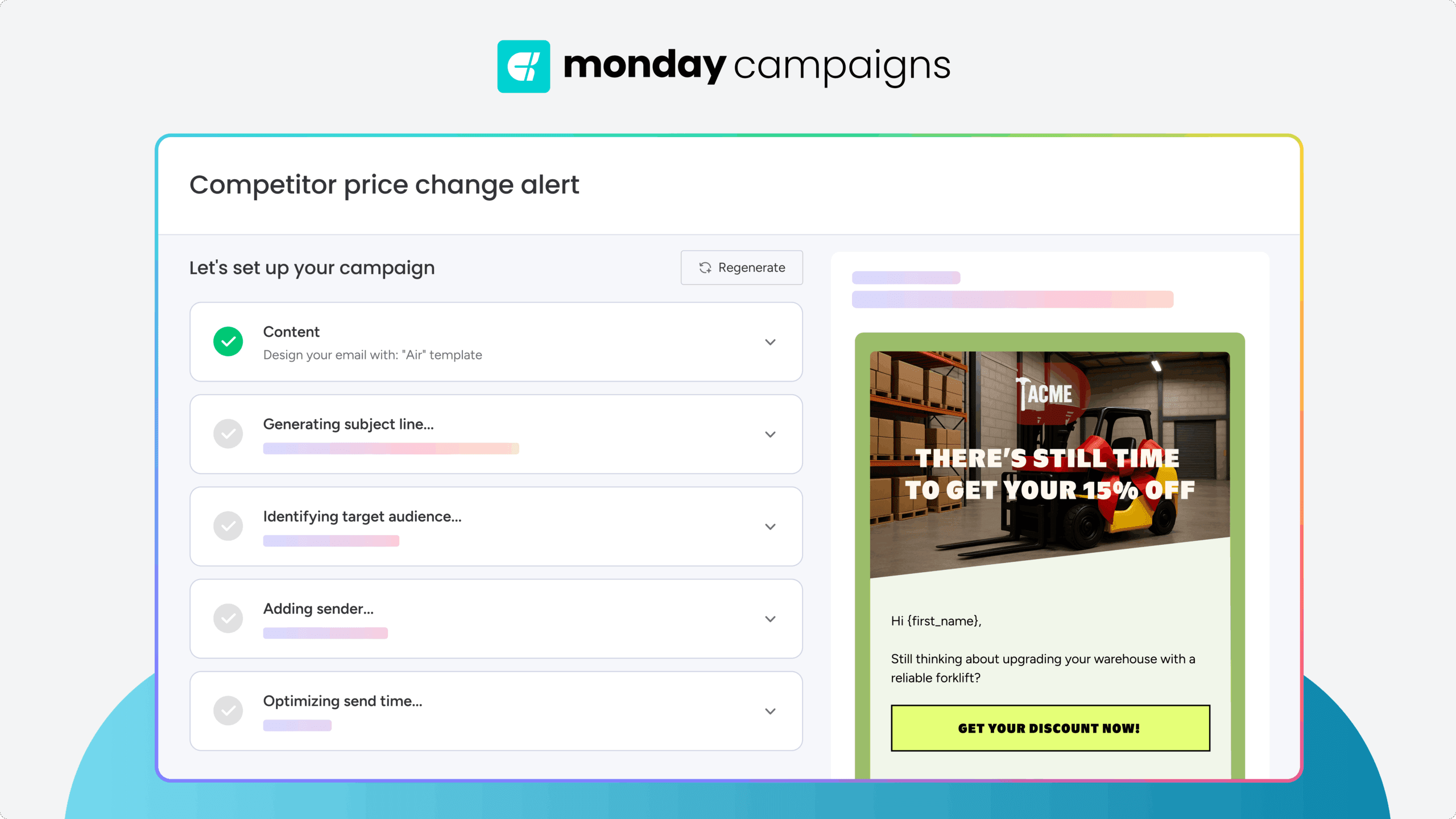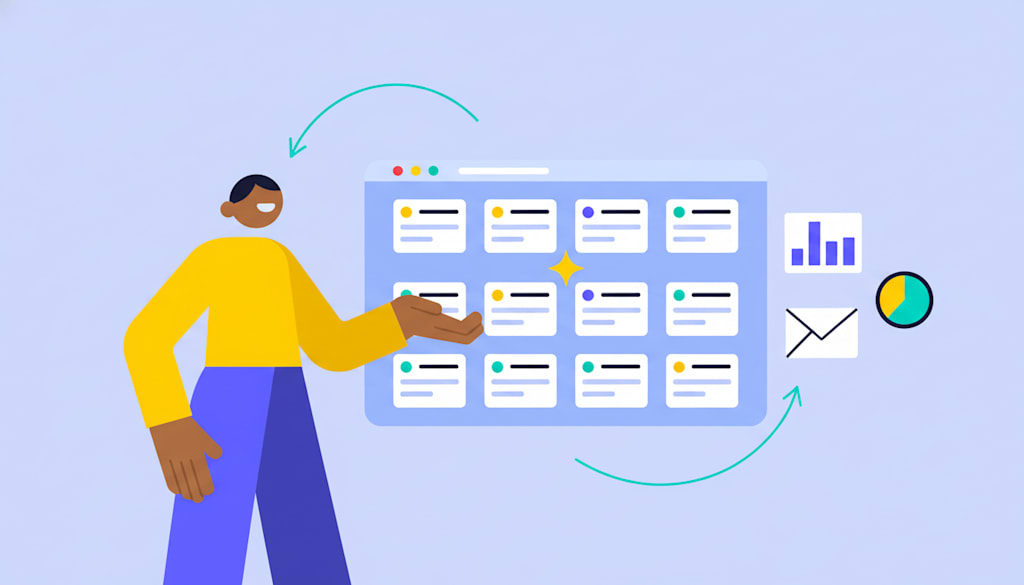Most marketing teams work across multiple channels — email, social, web, and more. But being everywhere isn’t the same as being connected. A true omnichannel strategy turns separate touchpoints into one continuous customer conversation, unifying data across every interaction. The result? Higher revenue, stronger loyalty, and teams that finally share the same customer view.
This guide breaks down how to build that strategy step-by-step. You’ll learn the key differences between omnichannel and multichannel marketing, the 7 stages of implementation, and how AI connects data and automates campaigns for a seamless customer experience.
Try monday campaignsKey takeaways
- Omnichannel strategy creates one continuous conversation with customers across all touchpoints, eliminating friction and boosting revenue through unified experiences.
- Start by mapping your current customer journey and identifying where customers lose context or encounter conflicting messages between channels.
- Focus on customer-centric metrics like lifetime value and cross-channel attribution rather than individual channel performance to measure true omnichannel success.
- Break down team silos by sharing unified dashboards and customer intelligence between marketing and sales to create seamless handoffs and coordinated outreach.
- AI-powered content creation combined with unified CRM data in monday campaigns enables personalized campaigns that maintain consistency across all channels automatically.
What is an omnichannel strategy?
An omnichannel strategy is a unified approach to customer engagement across all touchpoints — online, offline, mobile, social, and email. This means your customers experience consistent messaging and seamless transitions whether they’re browsing your website, reading emails, or visiting your store.
Think of it as creating one continuous conversation with your customers instead of separate, disconnected interactions. This approach leverages relationship marketing to maintain strong connections at every touchpoint. When someone starts shopping on their phone, they can finish on their laptop without starting over. When they contact support, the agent already knows their purchase history and preferences, boosting overall customer success.
The foundation of any omnichannel approach rests on 3 core elements:
- Unified customer data: Every interaction gets captured in one system that all channels can access
- Consistent messaging: Your brand voice stays the same across email, social media, and every other touchpoint
- Seamless transitions: Customers move between channels without losing context or repeating information
This approach transforms scattered marketing strategies into coordinated experiences that guide customers naturally through their journey.
Omnichannel vs. multichannel: key differences
Multichannel means being present on multiple platforms. Omnichannel means those platforms work together intelligently. The distinction shapes everything from customer satisfaction to revenue growth.
With multichannel marketing, you might run email campaigns, social media ads, and in-store promotions simultaneously. But if your marketing teams operate in isolation, each channel still functions independently. Your email team doesn’t know what social media is promoting. Store associates can’t see online browsing history.
| Multichannel | Omnichannel | |
|---|---|---|
| Data flow | Separate systems for each channel | Unified customer database across all channels |
| Campaign coordination | Teams plan and execute in isolation | Integrated planning and execution across teams |
| Customer view | Fragmented and inconsistent | 360-degree, real-time customer profile |
| Experience quality | Varies by channel and interaction | Consistent, connected experience everywhere |
| Measurement focus | Channel-specific performance | Cross-channel attribution and customer journey insights |
| Team alignment | Marketing, sales, and support operate separately | Shared dashboards and collaborative workflows |
| AI and automation | Limited or manual triggers | AI-driven personalization and trigger-based automation |
The impact on your business is immediate and measurable. Whereas multichannel creates friction — customers repeat information, receive conflicting offers, and feel like they’re dealing with different companies depending on the channel — omnichannel eliminates these pain points.
Why your business needs an omnichannel approach
Today’s customers interact with brands across multiple touchpoints before purchasing, with research showing that over half of B2C customers use 3-5 channels for a single purchase. This makes a consistent approach to B2C sales crucial if you want to reduce friction. They expect each interaction to build on the last one. Miss this expectation, and they’ll find a competitor who delivers.
The business case for omnichannel goes beyond meeting expectations. It directly impacts your bottom line, as effective personalization can increase revenue by 5-15 percent through stronger retention and operational efficiency.
Revenue grows when marketing teams align with your sales strategy to share real-time customer intelligence. Instead of working from disconnected spreadsheets, teams see complete interaction histories. This visibility enables precise targeting and shorter sales cycles. This type of collaborative CRM fosters better alignment across the entire organization.
Customer retention improves because experiences feel personal and connected. When your recommendations reflect someone’s complete history, cross selling and upselling become more effective, encouraging them to engage more and stay longer.
- Predictable growth: Unified data reveals which customer segments drive the most value
- Competitive differentiation: Stand out with experiences competitors can’t match
- Resource optimization: Eliminate duplicate efforts across teams
- Faster adaptation: Respond to market changes across all channels simultaneously
What today's customers expect from omnichannel experiences
Customers don’t think about channels. They think about their relationship with your brand. Every interaction should reflect their complete history, preferences, and needs.
These expectations shape purchase decisions and loyalty. Understanding them helps you design experiences that convert browsers into buyers and buyers into advocates.
Modern customers demand specific capabilities from the brands they choose:
- Recognition everywhere: Your website should know what they browsed last week. Email should reference their recent purchase. Support should see their entire history.
- Effortless transitions: Starting a purchase on mobile and completing it in-store should feel natural, with all information preserved.
- Relevant personalization: Recommendations and offers should reflect actual behavior, not generic segments.
- Proactive communication: Updates about orders, relevant products, and account changes should reach them on their preferred channel.
Meeting these expectations requires integrated systems and coordinated teams. monday campaigns enables this by connecting customer data with campaign execution, ensuring every message reflects complete customer context.
7 steps to build your omnichannel strategy
Building an effective omnichannel strategy requires systematic planning and execution. These steps create a framework for success while avoiding common pitfalls.
Step 1: Map your current customer journey
Start by documenting every touchpoint where customers interact with your brand, from the obvious channels like email and website to the hidden ones like customer service calls and social comments. This comprehensive view mirrors how a marketing funnel captures each stage of engagement, giving you the full picture of your customer’s experience.
Once you’ve identified all touchpoints, create a visual map showing how customers currently move between them. Pay special attention to where they lose context or encounter friction — those moments when they have to repeat information or receive conflicting messages are exactly where your omnichannel strategy will deliver the most value.
Step 2: Set clear omnichannel goals and KPIs
Establish measurable objectives that align with your broader business strategy, focusing on metrics that reflect integrated performance rather than individual channel success. The key is choosing KPIs like customer lifetime value, cross-channel conversion rates, and multi-touch attribution — metrics that reveal how your channels work together to drive results rather than competing for credit.
This shift in measurement philosophy ensures you’re optimizing for the customer experience, not just channel performance.
Step 3: Audit your marketing channels and tech stack
Take inventory of all your marketing platforms, CRM systems, and communication channels to understand your current landscape. As you list each tool, identify which ones share data effectively and which create silos that prevent seamless experiences.
Document how information flows between systems, and look for manual processes that slow you down or integration opportunities that could streamline operations and eliminate duplicate work.
Step 4: Build a unified customer data foundation
Create a centralized system that aggregates information from all touchpoints into comprehensive customer profiles. This unified view is what enables truly personalized experiences across channels, giving every team member access to the complete customer story.
With a native CRM integration, monday campaigns excels here by ensuring marketing and sales teams access the same real-time intelligence, eliminating silos and enabling the kind of coordinated outreach that customers appreciate.
Step 5: Create seamless cross-channel campaigns
Design campaigns that work consistently across all channels while maintaining your core message and adapting content for each platform’s unique requirements. The goal is to develop frameworks that allow for customization without losing your central messaging, ensuring that whether a customer sees your content on email, social media, or your website, they’re experiencing the same cohesive brand story.
Coordinate timing and offers across channels so customers receive aligned, complementary messages rather than competing or contradictory ones.
Pro tip: With monday campaigns, you can take this even further using trigger-based automation. Campaigns can launch automatically based on CRM updates or specific user actions — like completing a form, reaching a sales milestone, or engaging with an email — ensuring that every touchpoint happens at the most relevant moment.
Step 6: Align your marketing and sales teams
Break down the silos that prevent coordinated customer experiences by establishing shared goals, unified data access, and mutual accountability for outcomes. Set up communication processes and unified dashboards that keep everyone informed about customer interactions and campaign performance in real time.
Most importantly, create handoff procedures that preserve context when leads move from marketing to sales, so customers never have to repeat their story or feel like they’re starting from scratch.
Step 7: Measure, learn, and scale what works
Track performance across all channels to identify the patterns and touchpoint combinations that actually drive results. Rather than looking at channels in isolation, focus on understanding how they work together throughout the customer journey.
Establish regular review processes that help your teams learn from both successes and failures, then scale the tactics that prove effective while continuously testing performance across different customer segments to refine your approach over time.

Real-world omnichannel strategy examples
Theory is useful, but seeing omnichannel strategy in action makes the concept concrete. These examples show how real companies unified their customer experiences across channels — and the measurable results they achieved. Whether you’re in retail or B2B, these scenarios illustrate practical applications you can adapt for your own business.
Example 1: Retail brand
A leading apparel company noticed customers browsing online but purchasing in-store. By integrating online behavior data with in-store systems, they triggered personalized follow-up emails and mobile offers based on browsing history. This omnichannel approach increased repeat purchases and reduced cart abandonment within weeks.
Example 2: B2B SaaS company
A software provider unified marketing and sales data in its CRM, enabling automated follow-ups when prospects engaged with demo videos or webinar content. AI-driven segmentation in monday campaigns ensured each lead received tailored nurture content, boosting conversion rates across multiple channels.
Essential technologies for omnichannel success

Technology enables the integration, coordination, and personalization customers expect. The right stack eliminates manual work while providing real-time insights for exceptional experiences.
- Customer data platforms and CRM systems: These create unified profiles making personalization possible. They aggregate data from websites, emails, social media, and purchases into comprehensive records. Modern CRMs provide real-time behavioral insights, enabling marketing to create targeted campaigns while sales conducts relevant conversations.
- Marketing automation and campaign platforms: These orchestrate messaging across channels while maintaining consistency. Teams create multi-touch campaigns adapting to customer behavior, with automation triggering personalized messages at optimal moments. This increases relevance while reducing manual effort across your entire marketing operation.
- AI-powered personalization engines: AI analyzes customer data to recommend optimal messaging, timing, and channels for each interaction. Content adapts to individual preferences without manual intervention, enabling these systems to deliver personalization at scale without sacrificing quality.
- Analytics and attribution platforms: Omnichannel measurement requires tracking complete customer journeys, not isolated channel performance. These platforms reveal which touchpoint combinations actually drive results, helping you understand how channels work together to convert and retain customers.
Using AI to optimize and measure your omnichannel marketing

AI transforms omnichannel marketing from manual coordination into intelligent automation. It enables personalization strategies at scale, delivers predictive insights, and provides the visibility needed to understand what truly drives performance across channels.
By connecting CRM data, behavioral analytics, and campaign execution, AI helps teams both create smarter experiences and measure their real impact — ensuring every customer interaction adds to a complete, unified journey.
How AI enhances your omnichannel strategy
AI is the engine that makes true omnichannel marketing possible. It turns raw data into actionable insights, enabling teams to deliver consistent, personalized experiences across every touchpoint.
By combining predictive analytics with automation, AI ensures every interaction feels timely, relevant, and connected — no matter where customers engage.
- Dynamic content generation: Creates personalized copy that adapts to each customer’s preferences and behaviors.
- Predictive segmentation: Automatically identifies high-value segments and engagement likelihood to guide targeted outreach.
- Timing optimization: Determines the ideal moment to engage each customer based on activity patterns.
- Real-time adaptation: Adjusts offers and messaging as customers move across channels, ensuring relevance at every touchpoint.
Measuring ROI and performance intelligently
Traditional channel-based metrics can’t capture the full value of an omnichannel strategy. AI-powered analytics reveal how all touchpoints work together — turning disconnected data into actionable insights.
Focus on customer-centric metrics that reflect the strength of your connected experiences:
- Customer lifetime value (CLV): How integrated experiences increase long-term revenue.
- Cross-channel attribution: Which touchpoint combinations drive conversions.
- Channel synergy: How performance improves when channels reinforce each other.
- Retention impact: How seamless interactions strengthen customer loyalty.
These insights enable continuous improvement — helping teams refine strategy, personalize experiences further, and scale what’s working automatically.
How to solve 5 common omnichannel challenges
Every omnichannel implementation faces similar roadblocks. The good news? They’re predictable, which means they’re solvable. Here’s what you’ll likely encounter and exactly how to address each challenge:
| Challenge | What it looks like | How to solve it |
|---|---|---|
| Data silos preventing unified customer views | Information is trapped in disconnected tools, causing inconsistent messaging. | Implement platforms that integrate all channels and enforce data governance for consistent sharing. |
| Technology integration complexity | Tools don’t communicate, creating manual work and fragmented reporting. | Consolidate your stack and prioritize platforms with strong native integrations (like monday campaigns + CRM). |
| Team alignment and coordination issues | Marketing and sales goals conflict, leading to inconsistent outreach. | Share KPIs, dashboards, and processes across teams to enable seamless collaboration. |
| Budget constraints limiting rollout | Omnichannel transformation feels too resource-heavy. | Phase implementation—start with high-impact improvements and scale as ROI grows. |
| Measurement and attribution challenges | Cross-channel journeys are difficult to track accurately. | Use advanced analytics and journey-tracking tools to measure engagement holistically. |
How monday campaigns transforms your omnichannel strategy

Omnichannel complexity doesn’t have to slow you down. Addressing the core requirements of unified marketing in one platform, monday campaigns combines AI-powered content creation, centralized customer intelligence, and seamless team collaboration without the technical headaches.
Here’s what that actually looks like in practice:
- AI-powered content creation: Generate on-brand copy, subject lines, and campaign variations across email, social, and other channels in seconds. The AI learns your brand voice and maintains consistency automatically, so your team can focus on strategy instead of repetitive writing tasks.
- Unified customer intelligence: Native CRM integration means every campaign draws from complete customer profiles — purchase history, engagement patterns, support interactions, and behavioral data. Your outreach becomes genuinely personalized because it’s based on the full picture, not fragmented data.
- Dynamic segmentation: Audience segments update automatically as customer behavior changes in realtime. Someone who just made a purchase instantly moves to the right nurture track without manual list management or spreadsheet updates.
- Cross-channel marketing consistency: Maintain your brand standards while adapting content for each platform’s unique requirements. The same campaign flows seamlessly from email to social to web, with formatting and messaging optimized for where your customers are engaging.
- Real-time performance optimization: Built-in analytics reveal which messages, channels, and touchpoint combinations drive results. Use these insights to refine campaigns on the fly and scale what’s working across your entire strategy.
Launch a more unified customer experience
Omnichannel strategy is now essential for competitive success. Customers expect seamless experiences, and businesses must deliver or lose market share. Success requires integrated systems, coordinated teams, and intelligent automation working together — not as separate initiatives, but as one unified approach that puts customer experience first.
The right platform removes traditional barriers by combining AI capabilities, unified data, and collaboration features in one place. Teams create coordinated experiences while maintaining the agility to adapt quickly. Ready to transform your marketing with an AI-powered omnichannel approach?
Try monday campaignsFAQs
How long does it take to implement an omnichannel marketing strategy?
Implementing an omnichannel marketing strategy typically takes 3-6 months depending on your current technology stack and organizational readiness. Most businesses see initial results within the first month of launching integrated campaigns.
What budget should I allocate for omnichannel marketing transformation?
Budget allocation for omnichannel marketing transformation varies by company size and current infrastructure. Most organizations invest 15-25% of their annual marketing budget in the first year, with returns through improved retention and increased revenue per customer.
Can small businesses successfully implement omnichannel marketing strategies?
Small businesses can implement omnichannel strategies successfully, often with greater agility than larger organizations. Platforms like monday campaigns make sophisticated capabilities accessible without large technical teams.
How do you ensure data privacy compliance in omnichannel marketing?
Ensuring data privacy compliance requires proper consent management across touchpoints and platforms supporting GDPR and other regulations. Choose platforms with built-in privacy controls and audit trails for customer data usage.
What is the difference between omnichannel marketing and phygital experiences?
Omnichannel marketing creates integrated experiences across all channels, while phygital specifically blends physical and digital touchpoints. Phygital is a subset of omnichannel focusing on bridging online and offline experiences.
How do you measure the success of an omnichannel marketing strategy?
Measuring omnichannel success requires tracking customer lifetime value, cross-channel attribution, and satisfaction scores. Focus on how touchpoints work together driving outcomes, not individual channel metrics.
 Get started
Get started 

